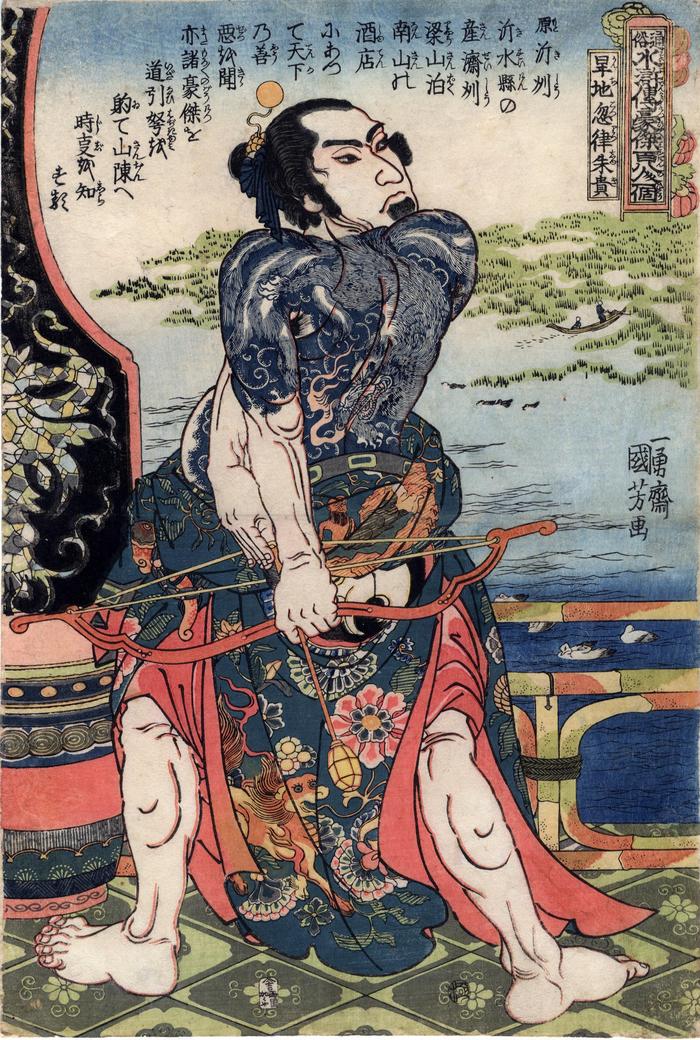Utagawa Kuniyoshi (歌川国芳) (artist 11/15/1797 – 03/05/1861)
Zhu Gui, the Dry-Land Crocodile (Kanchikotsuritsu Shuki - 旱地忽律朱貴) from the series from 108 Heroes of the Popular Suikoden All Told (Tsūzoku Suikoden gōketsu hyakuhachinin no hitori - 通俗水滸伝豪傑百八人之一個)
ca 1827 – 1830
10.25 in x 15.125 in (Overall dimensions) color woodblock print
Signed: Ichiyūsai Kuniyoshi ga
一勇斎国芳画
Publisher: Kagaya Kichiemon
Marks 195 - seal 22-025
Censor's seal: kiwame
British Museum - published by Ibaya Senzaburō
Hagi Uragami Museum of Art
Tokyo National Museum
Museum of Fine Arts, Boston - published by Ibaya Senzaburō
Ishikawa Prefectural Museum of Art
Bayerische Staatsbibliothek, München This is number 7 in Klompmakers' book on this series. It is also used on the front of the dust jacket.
Shuki is the owner of an inn near the headquarters of the band of brigands. He acts as a spy on their front lines. When he knows of a particularly vulnerable rich merchant he sends a special arrow in the direction of his cohorts' camp and they come and rob the man. When he or the group are threatened he also send one of his noise-producing arrows and the group jump into action.
"At times brutal, Shuki is known to murder travellers himself and sell their flesh as meat and their fat as lamp fuel. [Later he] becomes one of the captains of the Ryōsanpaku gang..." Source and quote from: Of Brigands and Bravery: Kuniyoshi's Heroes of the Suikoden, p. 54.
****
Generally the text reads: 原(もと)沂州(きしう)の沂水縣(きすいけん)の産(さん)濟州(せいしう)梁山泊(りやうさんぱく)南山(なんさん)の酒店(しゆてん)にあつて天下(てんか)の善悪(ふうぜつ)を聞(きゝ)亦(また)諸豪傑(もろもろのがうけつ)を道引(いざなひ)弩(はぢきゆみ)を射(ゐ)て山陳(さんぢん)へ時㕝(じじ)を知(しら)する
This passage is translated in the 2013 Kuniyoshi book by Iwakiri and Amy Reigle Newland:
Hailing from Motokishū, Kisui [Ch: Yishui] county, he had a sake shop at Nanzan [Ch: Nanshan] on the Ryōzanpaku marsh in Seishū [Jizhou] province, where he hears all the gossip and welcomes the many heroes. He shoots arrows as a signal to the [gang's] base on the mountain, thereby informing the mountain camp about what is going on.****
We first encounter Zhu Gui in Chapter 11 of the Outlaws of the Marsh, p. 176:
"You are one of them and I didn't know," Lin [Chong] exclaimed. "I 'had eyes and didn't recognize Mount Taishan!' Please tell me your name." He bowed politely.****
The man returned the bow. "This humble person is the lookout for Chieftain Wong. I am called Zhu Gui. I come originally from Yishui County in Yizhou Prefecture. Among the fraternity I'm known as the Dry-Land Crocodile. In the guise of running this wine shop my job is to observe the movements of merchants and travellers. I let the stronghold know if they are carrying anything of value. When you asked about Liangshan Marsh I thought I'd better find out more about you. Then you wrote your name on the wall, and I remembered people from the capital telling of your gallantry. I never thought we'd meet here today. Since lord Chai has written an introduction, Chieftain Wang is sure to welcome a man of your splendid reputation."
Zhu Gui feasted Lin with a meal of fish and meat and wine and delicacies. They ate and drank in the waterside room till half the night was gone."
[*****]
There are other copies of this print in the Ota Memorial Museum of Art and the Ishibi Prefectural Museum.
****
We know that this print was published over time by two different publishers. One was Kagaya Kichiebei and the other Ibaya Senzaburō. We have compared the prints produced by both houses and feel that on looks alone the one by Kagaya Kichibei is the earlier of the two. This is confirmed by the fact that the example in the British Museum, published by Ibaya Senzaburō, shows a seal only used in 1847, according to Andreas Marks.
Confirmation: the first editions were published by Kagiya Kichiemon and the later ones were by Ibaya Sensaburō
Klompmakers wrote on page 34-35 of Brigands and Bravery: "Kagaya Kichibei ordered so many sheets to be pulled of select designs that the woodblocks wore out and in around 1845 the publisher Ibaya Sensaburō reissued the prints of Kuniyoshi's first Suikoden series."
****
Illustrated in:
1) black and white in Utagawa Kuniyoshi, Springfield Museum of Art, 1980, #8.
2) color in Kuniyoshi: Japanese master of imagined worlds by Iwakiri Yuriko with Amy Reigle Newland, Hotei Publishing, 2013, p. 35, pl.11. "Kuniyoshi depicts the hero with a magnificent tattoo of a nine-tailed fox on his back; however, no mention is made of this body decoration in the original Water margin tale. The wall to the left is ornamented with what is meant to be mother-of-pearl."
3) a full-page color reproduction in Gems of the floating world : ukiyo-e prints from the Dresden Kupferstich-Kabinett by Rose Hempel, Japan Society, 1995, pp. 130-131. Hempel gave the title ending with 'Portrayed Individually' rather than 'All Told'. She notes that his hair is held back by delicate hair ornaments. Like other sources, she notes that he was running a winery.
4) in color in Kuniyoshi 国芳 by Jūzō Suzuki (鈴木重三), Heibonsha Limited, Publishers, 1992, no. 79.
Hempel wrote: "Kuniyoshi began this series in 1827. The stage had been set for it in 1805, when the Japaneses writer Takizawa Bakin (1767-1848) published a Japanese version of the Chinese novel Shuihuchuan (Suikoden) by Shih Nai-ngan, which takes place in the 11th century. It was a sensational success due to Hokusai's illustrations. B. W. Robinson describes Kuniyoshi's woodblocks: "They give the impression of an almost superhuman release of energy; the contorted figures with their strange and terrible weapons seem to burst from the confines of the ōban-sheet. It is no wonder that the public responded with enormous enthusiasm, urging the artist on till he had completed over seventy of these masterful designs." "
5) in a full-page in a color reproduction in Of Brigands and Bravery: Kuniyoshi's Heroes of the Suikoden by Inge Klompmakers, Hotei Publishing, 1998, #7, p. 55.
warrior prints (musha-e - 武者絵) (genre)
Suikoden (水滸傳) (genre)
Kagaya Kichiemon (加賀屋吉右衛門) (publisher)
